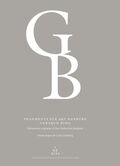
Aby Warburg and Cultures of Religion
The Hamburg art and cultural historian Aby Warburg (1866–1929) is not only the founder of the Kulturwissenschaftliche Bibliothek Warburg (KBW), but also a key contributor to research in many disciplines of the humanities and cultural studies up to this day. He has repeatedly pointed out how important the study of religions is for the understanding of cultural-historical contexts. Anyone who wants to gain deeper insights into the symbolic forms and cultural traditions in text and image as well as into the course of their “wandering routes” (Wanderstrassen) must be interested in what has been created within the religions and their “devotional and intellectual space” since the primordial times of the primitive “Greifmensch” (as he called him).
Warburg wanted to “improve the method of cultural studies by linking art history and religious studies”, as he explained in his essay on Luther and astrology shortly after the First World War. In doing so, he asserted the simultaneity of symbolic and affect-historical traditions with which primitive-indigenous, pagan-antique and the ancient Mediterranean cultures of religion have shaped the history of European pictorial memory. From this, pathos formulas emerged, stereotypical gestures that express the most intense suffering as well as burning passion (both are meanings of pathos).
The research project was not concerned with theology or the history of faith, but rather with cultural history with recourse to pictorial and religious questions. The object of examination was not what was circulated or preached in churches, synagogues or mosques, but the pictorial, medial, rhetorical and textual forms in which these transfers of knowledge took place. It is by no means a comprehensive study, but rather focused on materials and practices drawn from Warburg’s own projects. The places he himself ascribed to respective religious cultures in his sketches of the history of human development prove to be less interesting, as there he largely followed the mainstream of his time. But in figures such as those of multiple layers and superimposition, as well as in the thought image of Nachleben (which creates its own predecessors), this conventionality is dynamized and shattered. It is less the Warburg of philologists than that of surrealists that was analyzed in this research project, albeit often with methods from the history of concepts and religions.
In this project, we closely examined the position, function, significance, and sustained impact of cultures of religion in Warburg’s writings published during his lifetime as well as posthumously, including his manuscripts, records, correspondence, diaries and card indexes (Zettelkästen). Finally, his idea of the KBW not as a mere collection of books but as machine à penser was duly considered. The research project aimed at going beyond a close-up biographical study on Warburg; it opened up insights into the “laboratory of visual history in cultural studies” (Luther essay) and set a new accent in international cultural studies research.
Fig. above: Aby Warburg’s Bilderatlas Mnemosyne. Display of the picture plates in the reading room of the KBW, autumn 1929. © Warburg Institute London
See also:
ZfL project Aby Warburg: Volume of Works (Edition) (2008–2009)
Publications
Édité par Philippe Despoix et Martin Treml. Avant-propos de Carlo Ginzburg
Gertrud Bing: Fragments sur Aby Warburg
Documents originaux et leur traduction française
Teología política e imagen
Martin Treml
- Passio als Leid und Leidenschaft. Aby Warburgs Bilderatlas, in: Björn Bertrams, Antonio Roselli (eds.): Selbstverlust und Welterfahrung. Erkundungen einer pathischen Moderne. Wien, Berlin: Turia + Kant 2021, 254–279
Events
Martin Treml: Passio als Leid und Leidenschaft. Aby Warburgs Bilderatlas
Carl von Ossietzky Universität Oldenburg, Ammerländer Heerstraße 114-118, 26129 Oldenburg, A14 1-111 (Senatssitzungssaal)
Martin Treml: »Meine dreckigen Götter«. Sigmund Freuds Psychoanalyse und das Nachleben der Religionskulturen
IFK Internationales Forschungszentrum Kulturwissenschaften | Kunstuniversität Linz in Wien, Reichsratsstr. 17, 1010 Wien (Österreich)
Martin Treml: Erich Auerbach und die Religionskultur
Karl Jaspers-Haus, Unter den Eichen 22, 26122 Oldenburg
Kulturtheorie und die Analyse von Religionskulturen
Universität Wien, Institut für Theater-, Film- und Medienwissenschaft, Hofburg Batthyanystiege, 1010 Wien (1. Stock), Jura-Soyfer-Saal
Martin Treml: Moria, Golgatha, Mekka. Zum Sohnesopfer in Judentum, Christentum, Islam
Freie Universität Berlin, Holzlaube, Fabeckstraße 23–25, 14195 Berlin, Raum 2.2063

